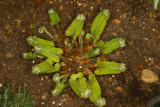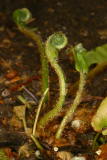Additional notes (click to expand)
Medicinal
Culpeper recommends a syrup made of the leaves for ‘hardness and stoppings of the spleen and liver, and the heat of the stomach, lax and the bloody flux’. He recommends a distillation of the leaves ‘against the passions of the heart, to stay the hiccough, to keep the falling of the palate’. He goes on to recommend the distillation as a remedy for bleeding gums, when used as a gargle.
Culpeper (attributed to) , N. Culpeper's Complete Herbal. W. Foulsham, London.
Nomenclature
Asplenium from Greek 'splen', relating to its use as a herb for the spleen
Scolopendrium from Greek 'skolopendra', meaning millipede, and a reference to the arrangement of the spores on the underside of the fronds.
Stearn, W.T.. (1992). Stearn's Dictionary of Plant Names for Gardeners. Cassell.
Geographical distribution
- Africa, Macaronesia, Canary Is.
- Africa, Northern Africa, Algeria
- Africa, Northern Africa, Libya
- Africa, Northern Africa, Morocco
- Africa, Northern Africa, Tunisia
- Asia-Temperate, Caucasus, North Caucasus
- Asia-Temperate, Caucasus, Transcaucasus
- Asia-Temperate, China
- Asia-Temperate, Eastern Asia, Japan
- Asia-Temperate, Eastern Asia, Korea
- Asia-Temperate, Russian Far East
- Asia-Temperate, Western Asia, Israel
- Asia-Temperate, Western Asia, Jordan
- Asia-Temperate, Western Asia, Lebanon-Syria
- Asia-Temperate, Western Asia, Turkey
- Europe, Eastern Europe
- Europe, Middle Europe
- Europe, Northern Europe
- Europe, Northern Europe, Great Britain
- Europe, Northern Europe, Ireland
- Europe, Southeastern Europe
- Europe, Southwestern Europe
Asplenium scolopendrium L.
Family: ASPLENIACEAEGenus: Asplenium
Species: scolopendrium L.
Common names: Hart's Tongue Fern; Burnt Weed; Button Hole; Christ's Hair.
Pharmacopoeia Londinensis name: Scolopendrion/Ceterach
Distribution summary: Eurasia, N.America
Habit: Perennial
Hardiness: H5 - Hardy; cold winter
Habitat: Damp, humus-rich soil in partial shade, on rocky hillsides, streamsides & clearings
Garden status: Currently grown
Garden location: Plants of the World (C), Pharmacopoeia Londinensis 1618 'Leaves' (HSE 6)
Reason for growing: Medicinal
.JPG)
.JPG)


.JPG)
.JPG)
